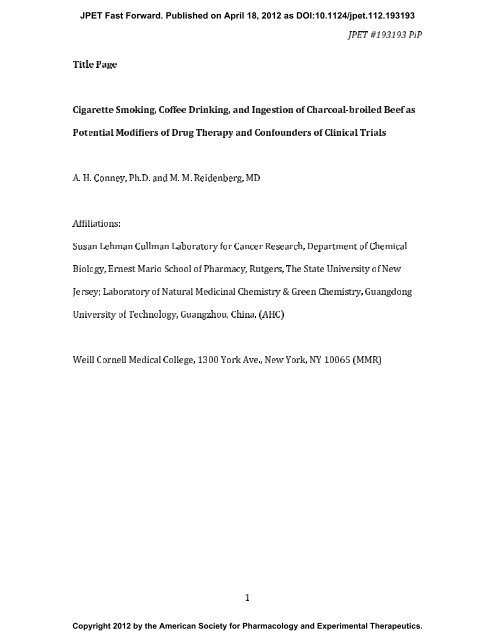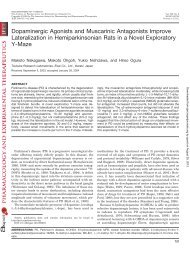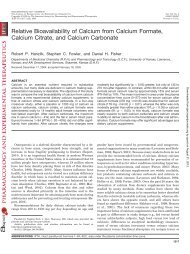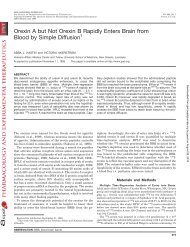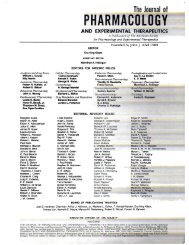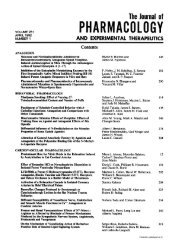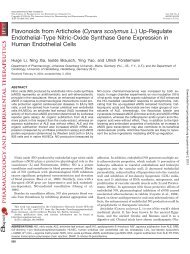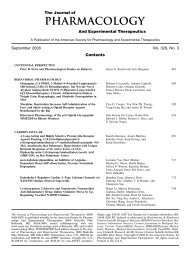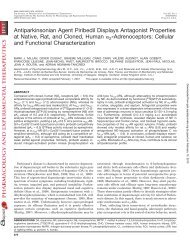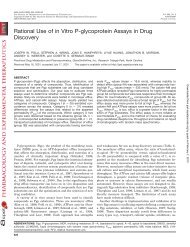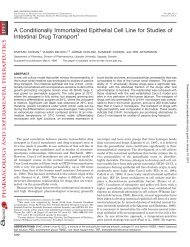Title Page Cigarette Smoking, Coffee Drinking, and Ingestion of ...
Title Page Cigarette Smoking, Coffee Drinking, and Ingestion of ...
Title Page Cigarette Smoking, Coffee Drinking, and Ingestion of ...
Create successful ePaper yourself
Turn your PDF publications into a flip-book with our unique Google optimized e-Paper software.
JPET Fast Forward. Published on April 18, 2012 as DOI:10.1124/jpet.112.193193<br />
<strong>Title</strong> <strong>Page</strong><br />
1<br />
JPET #193193 PiP<br />
<strong>Cigarette</strong> <strong>Smoking</strong>, <strong>C<strong>of</strong>fee</strong> <strong>Drinking</strong>, <strong>and</strong> <strong>Ingestion</strong> <strong>of</strong> Charcoal-broiled Beef as<br />
Potential Modifiers <strong>of</strong> Drug Therapy <strong>and</strong> Confounders <strong>of</strong> Clinical Trials<br />
A. H. Conney, Ph.D. <strong>and</strong> M. M. Reidenberg, MD<br />
Affiliations:<br />
Susan Lehman Cullman Laboratory for Cancer Research, Department <strong>of</strong> Chemical<br />
Biology, Ernest Mario School <strong>of</strong> Pharmacy, Rutgers, The State University <strong>of</strong> New<br />
Jersey; Laboratory <strong>of</strong> Natural Medicinal Chemistry & Green Chemistry, Guangdong<br />
University <strong>of</strong> Technology, Guangzhou, China. (AHC)<br />
Weill Cornell Medical College, 1300 York Ave., New York, NY 10065 (MMR)<br />
Copyright 2012 by the American Society for Pharmacology <strong>and</strong> Experimental Therapeutics.
Running <strong>Title</strong> <strong>Page</strong><br />
Running title: Polycyclic hydrocarbons <strong>and</strong> drug metabolism<br />
Corresponding author:<br />
Allan H. Conney, Susan Lehman Cullman Laboratory for Cancer Research,<br />
2<br />
JPET #193193 PiP<br />
Department <strong>of</strong> Chemical Biology, Ernest Mario School <strong>of</strong> Pharmacy, Rutgers, The<br />
State University <strong>of</strong> New Jersey, 164 Frelinghuysen Road, Piscataway, NJ 08854<br />
Phone: 732-445-4940, Fax: 732-445-0687, Email: aconney@pharmacy.rutgers.edu<br />
The number <strong>of</strong> text pages: 11<br />
The number <strong>of</strong> tables: 3<br />
The number <strong>of</strong> figures: 4<br />
The number <strong>of</strong> references: 43<br />
The number <strong>of</strong> words in the Abstract: 105<br />
Number <strong>of</strong> words in the text: 3,009
Abstract<br />
3<br />
JPET #193193 PiP<br />
A pathway <strong>of</strong> research is described leading from the finding <strong>of</strong> an inhibitory effect <strong>of</strong><br />
3-methylcholanthrene on the carcinogenicity <strong>of</strong> an aminoazo dye, to the induction <strong>of</strong><br />
drug-metabolizing enzymes by 3-methylcholanthrene, benzo[a]pyrene <strong>and</strong> other<br />
polycyclic aromatic hydrocarbons, to the demonstration <strong>of</strong> enhanced drug<br />
metabolism in cigarette smokers, c<strong>of</strong>fee drinkers <strong>and</strong> in people eating charcoal-<br />
broiled beef. The results <strong>of</strong> these studies indicate that cigarette smoking, c<strong>of</strong>fee<br />
drinking <strong>and</strong> the ingestion <strong>of</strong> charcoal-broiled beef (all result in exposure to<br />
polycyclic aromatic hydrocarbons) can influence the dosing regimen needed for<br />
proper drug therapy <strong>and</strong> are potential confounders <strong>of</strong> clinical trials with drugs<br />
metabolized by polycyclic aromatic hydrocarbon-inducible enzymes.
It is well known that there are large differences in the dose-response<br />
4<br />
JPET #193193 PiP<br />
relationship <strong>of</strong> drugs from one person to another that are dependent on both<br />
genetic <strong>and</strong> environmental factors that influence drug metabolism. Although<br />
genotyping patients for drug-metabolizing enzymes prior to drug therapy can help<br />
establish a proper initial dosing regimen for individual patients, environmental<br />
modulation <strong>of</strong> drug metabolism is also important <strong>and</strong> requires a different approach<br />
for establishing a proper dosing regimen.<br />
Early research by H.L. Richardson demonstrated that administration <strong>of</strong> the<br />
carcinogen 3-methylcholanthrene to rats unexpectedly inhibited the<br />
hepatocarcinogenicity <strong>of</strong> an aminoazo dye (Richardson et al, 1952). This report was<br />
followed by a research program that showed why a carcinogenic polycyclic aromatic<br />
hydrocarbon (PAH) inhibited the tumorigenicity <strong>of</strong> a carcinogenic aminoazo dye <strong>and</strong><br />
provided a springboard that led to research showing stimulatory effects <strong>of</strong> cigarette<br />
smoking, the eating <strong>of</strong> charcoal-broiled beef, <strong>and</strong> c<strong>of</strong>fee drinking on the metabolism<br />
<strong>of</strong> certain drugs. In these early studies, it was demonstrated that administration <strong>of</strong><br />
3-methylcholanthrene, benzo[a]pyrene or several other PAHs induced the synthesis<br />
<strong>of</strong> hepatic enzymes that metabolized aminoazo dyes to noncarcinogenic products<br />
(Brown et al, 1954; Conney, 1954; Conney et al, 1956). This work, which was done<br />
more than 50 years ago, was the first demonstration <strong>of</strong> the induction <strong>of</strong> xenobiotic-<br />
metabolizing enzymes <strong>and</strong> led to further research demonstrating a stimulatory<br />
effect <strong>of</strong> administration <strong>of</strong> benzo[a]pyrene <strong>and</strong> other PAHs on the metabolism <strong>of</strong><br />
several drugs <strong>and</strong> to the finding <strong>of</strong> stimulatory effects <strong>of</strong> cigarette smoking,
5<br />
JPET #193193 PiP<br />
ingestion <strong>of</strong> charcoal-broiled beef <strong>and</strong> c<strong>of</strong>fee drinking on drug metabolism in<br />
animals <strong>and</strong> humans.<br />
The stimulatory effect <strong>of</strong> i.p. injections <strong>of</strong> 3-methylcholanthrene on the oxidative<br />
N-demethylation <strong>and</strong> the reductive cleavage <strong>of</strong> aminoazo dyes to noncarcinogenic<br />
metabolites by the liver is shown in Fig 1 (Brown et al, 1954; Conney, 1954; Conney<br />
et al, 1956), <strong>and</strong> the stimulatory effect <strong>of</strong> benzo[a]pyrene on its own metabolism<br />
<strong>and</strong> on the hepatic metabolism <strong>of</strong> the muscle relaxant drug zoxazolamine is shown<br />
in Fig. 2 (Conney et al, 1960; Conney et al, 1959; Conney et al, 1957). A single i.p.<br />
injection <strong>of</strong> benzo[a]pyrene 24 hr prior to administration <strong>of</strong> zoxazolamine had a<br />
dramatic stimulatory effect on the in vivo metabolism <strong>of</strong> this drug (Fig 2), <strong>and</strong> the<br />
duration <strong>of</strong> action <strong>of</strong> zoxazolamine was decreased from 730 min to only 17 min<br />
(Conney et al, 1960). Studies on the enzyme-inducing activity <strong>of</strong> a large number <strong>of</strong><br />
PAHs indicated that many environmental PAHs with 4 or more rings when<br />
administered by i.p. injection to rats are potent inducers <strong>of</strong> hepatic aminoazo dye N-<br />
demethylase (Arcos et al, 1961). Modest inducing activity was also observed in mice<br />
fed 3-methylcholanthrene, benz[a]anthracene, pyrene or phenanthrene for one<br />
week (Brown et al, 1954; Conney, 1954). Later studies indicated that PAHs were<br />
potent inducers <strong>of</strong> cytochromes P450 1A1 <strong>and</strong> 1A2. Since PAHs that induce certain<br />
drug-metabolizing enzymes are present in tobacco smoke <strong>and</strong> in charcoal-broiled<br />
beef (Table 1) (H<strong>of</strong>fmann et al, 1978; Lijinsky et al, 1964), the effects <strong>of</strong> cigarette<br />
smoking <strong>and</strong> eating charcoal-broiled beef on the metabolism <strong>of</strong> substances that are<br />
metabolized by PAH-inducible enzymes were evaluated in humans.
6<br />
JPET #193193 PiP<br />
<strong>Cigarette</strong> smokers had greatly elevated levels <strong>of</strong> placental benzo[a]pyrene<br />
hydroxylase, aminoazo dye N-demethylase <strong>and</strong> zoxazolamine hydroxylase activities<br />
(Table 2) (Kapitulnik et al, 1976; Welch et al, 1968; Welch et al, 1969), which are<br />
PAH-inducible enzymes in rodents. In additional studies, cigarette smoking or eating<br />
charcoal-broiled beef lowered the plasma levels <strong>of</strong> phenacetin (a CYP1A1/2<br />
substrate) without altering its half-life (Fig 3) (Conney et al, 1976; Pantuck et al,<br />
1976; Pantuck et al, 1974a; Pantuck et al, 1972). In these studies, the ratio <strong>of</strong> N-<br />
acetyl-p-aminophenol (phenacetin’s major metabolite) to phenacetin was increased<br />
by 2- to 5-fold at the different time intervals after administration <strong>of</strong> phenacetin, <strong>and</strong><br />
it was suggested that cigarette smoking or eating charcoal-broiled beef enhanced<br />
the intestinal metabolism <strong>of</strong> phenacetin. In accord with this concept, administration<br />
<strong>of</strong> benzo[a]pyrene, exposure to cigarette smoke, or the feeding <strong>of</strong> charcoal-broiled<br />
beef stimulated the metabolism <strong>of</strong> phenacetin by rat intestine (Pantuck et al, 1975;<br />
Pantuck et al, 1974a; Pantuck et al, 1974b). It is likely that eating other charcoal-<br />
broiled foods such as charcoal-broiled chicken or fish will also stimulate the<br />
metabolism <strong>of</strong> drugs that are metabolized by PAH-inducible enzymes.<br />
PAHs are formed during the roasting <strong>of</strong> c<strong>of</strong>fee beans (Houessou et al, 2007), <strong>and</strong><br />
the concentrations <strong>of</strong> various PAHs in several c<strong>of</strong>fee brews are shown in Table 3<br />
(Orecchioa et al, 2009). Administration <strong>of</strong> c<strong>of</strong>fee to rats increased the level <strong>of</strong><br />
hepatic CYP1A2, <strong>and</strong> this effect <strong>of</strong> c<strong>of</strong>fee was partially lost in decaffeinated c<strong>of</strong>fee<br />
suggesting that both caffeine <strong>and</strong> non-caffeine components (probably PAHs) play a<br />
role for the effect <strong>of</strong> c<strong>of</strong>fee administration to increase the level <strong>of</strong> hepatic CYP1A2 in<br />
rats (Turesky et al, 2003). A recent study indicates that c<strong>of</strong>fee drinkers have
7<br />
JPET #193193 PiP<br />
enhanced 3-demethylation <strong>of</strong> caffeine, which occurs predominately by CYP1A2<br />
(Djordjevic et al, 2008). About 5-10% <strong>of</strong> commonly prescribed drugs undergo<br />
metabolism by CYP1A2. Examples <strong>of</strong> drugs that are metabolized to a significant<br />
extent by CYP1A2 include caffeine, theophylline, phenacetin (no longer marketed),<br />
tizanidine, clozapine, fluvoxamine, olanzapine, zoxazolamine (no longer marketed),<br />
<strong>and</strong> tacrine. In summary, cigarette smoking, c<strong>of</strong>fee drinking, <strong>and</strong> the ingestion <strong>of</strong><br />
charcoal-broiled beef can stimulate drug metabolism, alter the dosing regimen<br />
needed for proper drug therapy, <strong>and</strong> these modifiers <strong>of</strong> drug metabolism are<br />
potential confounders during clinical trials with drugs that are metabolized by PAH-<br />
inducible enzymes.<br />
Other sources <strong>of</strong> environmental exposure to PAHs are from the burning <strong>of</strong> coal,<br />
wood <strong>and</strong> gasoline as well as from petroleum refining so that people heavily<br />
exposed to these sources <strong>of</strong> PAHs would be expected to have enhanced metabolism<br />
<strong>of</strong> drugs that are metabolized by cytochromes P450 1A1 <strong>and</strong> 1A2.<br />
These data on common environmental factors which increase the rate <strong>of</strong> drug<br />
metabolism raise three important clinical concerns:<br />
The first concern is related to the variability <strong>of</strong> dose-response among different<br />
individuals in a population. This is especially relevant in a clinical trial. Fig. 4<br />
(Asberg, 1974) shows the range <strong>of</strong> concentrations <strong>of</strong> nortriptyline in the plasma <strong>of</strong><br />
248 people taking 150 mg/d <strong>of</strong> the drug. This greater than 6 fold range from the<br />
lowest to the highest concentration is representative <strong>of</strong> what occurs with many<br />
drugs eliminated by metabolism. In an additional study, the plasma level <strong>of</strong><br />
desmethylimipramine varied by 36-fold in eleven different individuals receiving the
8<br />
JPET #193193 PiP<br />
same 75mg daily dose <strong>of</strong> the drug (Hammer et al, 1967). Although variability in the<br />
metabolism <strong>of</strong> nortriptyline <strong>and</strong> desmethylimipramine that occurs in different<br />
individuals is related primarily to genetic polymorphisms in CYP2D6, the<br />
metabolism <strong>of</strong> these compounds can also be regulated by environmental factors,<br />
<strong>and</strong> person-to-person differences in plasma levels described in Fig. 4 illustrate<br />
variability in metabolism that can occur from both genetic <strong>and</strong> environmental<br />
factors that regulate drug metabolism. For nortriptyline, the best efficacy is when<br />
the concentration is 50-140 ng/ml (Asberg et al, 1971) or about a 3 fold range.<br />
While the dose <strong>of</strong> 150 mg/d had most patients in this range, many patients had<br />
lower or higher levels causing less efficacy or increased risk <strong>of</strong> an adverse effect,<br />
respectively. Adjusting the dose to allow for a person’s rate <strong>of</strong> metabolism can bring<br />
the drug level into the therapeutic range with the intended intensity <strong>of</strong> effect. One<br />
study <strong>of</strong> only 10 patients receiving a dose <strong>of</strong> 8mg tizanidine found a mean peak<br />
concentration <strong>of</strong> 25 pg/ml with a range <strong>of</strong> 15-43 pg/ml, a 3 fold range in only 10<br />
patients (Mathias et al, 1989). Since induction speeds drug metabolism, an induced<br />
population <strong>of</strong> subjects in a trial will lack the very slow metabolizers that occur in the<br />
general population. The trial will fail to detect subjects who would have had high<br />
drug levels at the studied dose if they were not induced. The interpretation <strong>of</strong> the<br />
trial will be that the observations represent the drug levels <strong>and</strong> effects <strong>of</strong> this dose<br />
for the general population. It will fail to recognize that the fraction <strong>of</strong> the population<br />
that are un-induced slow metabolizers will have higher levels than seen in the trial<br />
<strong>and</strong> possibly overdose at the studied dose. Thus, unanticipated toxicity may occur<br />
after marketing.
9<br />
JPET #193193 PiP<br />
A second concern relates to the size <strong>of</strong> the population needed to determine the<br />
effectiveness <strong>of</strong> an agent being studied in a clinical trial. The presence <strong>of</strong> a moderate<br />
number <strong>of</strong> individuals with induced drug-metabolizing activity may magnify<br />
variability <strong>of</strong> response in the population studied thereby requiring more subjects to<br />
determine effectiveness <strong>of</strong> the substance being evaluated. Measurement <strong>of</strong> blood or<br />
saliva levels <strong>of</strong> drug during the course <strong>of</strong> the trial will help in interpretation <strong>of</strong> the<br />
trial.<br />
A third concern relates to patient care. A person taking a medicine who then<br />
ingests an inducer may have an increase in the rate <strong>of</strong> drug metabolism. The extent<br />
<strong>of</strong> the increase depends on the dose <strong>of</strong> inducer <strong>and</strong> the sensitivity <strong>of</strong> the person to it<br />
(Mathias et al, 1989). This induction will increase the rate <strong>of</strong> metabolism <strong>of</strong> the drug<br />
<strong>and</strong> decrease the drug level <strong>and</strong> efficacy <strong>and</strong> benefit from taking the medicine. If the<br />
dose is then raised to allow for the new rate <strong>of</strong> metabolism <strong>and</strong> the inducer is<br />
subsequently stopped, such as when the patient finally quits smoking or stops<br />
charcoal-broiling or drinking c<strong>of</strong>fee, the induced state will subside <strong>and</strong> the drug<br />
level <strong>and</strong> intensity <strong>of</strong> effect will go up. Toxicity may follow if the dose is not reduced.<br />
This was reported for a patient taking clozapine <strong>and</strong> another taking olanzapine.<br />
Each stopped smoking <strong>and</strong> developed toxicity from their medicine (Breckenridge et<br />
al, 1973).<br />
Research in patients has found that smokers have lower concentrations <strong>of</strong> many<br />
<strong>of</strong> the clinically important drugs metabolized by PAH-inducible enzymes than<br />
nonsmokers when given the same dose. This has been shown for haloperidol (Jann<br />
et al, 1986) <strong>and</strong> tacrine (Zevin et al, 1999). Other examples are: fluvoxamine levels
10<br />
JPET #193193 PiP<br />
in smokers are 1/3 that <strong>of</strong> nonsmokers (Spigset et al, 1995), clozapine levels are 1/3<br />
lower for men, 1/5 for women compared to nonsmokers (Haring et al, 1989), <strong>and</strong><br />
smoker olanzapine levels are 1/5 that <strong>of</strong> nonsmokers (Carrillo et al, 2003). Clearly<br />
cessation <strong>of</strong> smoking can cause “overdose” toxicity for a patient taking any <strong>of</strong> these<br />
medications <strong>and</strong> then stops smoking.<br />
Thus, the experimental animal studies indicating an inhibitory effect <strong>of</strong> one<br />
carcinogen (a polycyclic aromatic hydrocarbon) on the action <strong>of</strong> another carcinogen<br />
(an aminoazo dye) led to additional research demonstrating polycyclic aromatic<br />
hydrocarbon-induced synthesis <strong>of</strong> drug-metabolizing enzymes that has relevance<br />
for clinical trials <strong>and</strong> for the care <strong>of</strong> sick people.<br />
Perspectives for the future<br />
Although we have focused in the present article on early basic research that<br />
led to the discovery <strong>of</strong> the effects <strong>of</strong> cigarette smoking, c<strong>of</strong>fee drinking <strong>and</strong> charcoal-<br />
broiled beef ingestion on drug metabolism in humans, there are many factors that<br />
influence rates <strong>of</strong> drug metabolism that are important for explaining differences in<br />
drug response in different individuals receiving the same dose <strong>of</strong> drug <strong>and</strong> in the<br />
same individual on different occasions. In earlier studies, we found substantial<br />
differences in the metabolism <strong>of</strong> phenacetin in individuals leading an unrestricted<br />
life-style when given phenacetin on several occasions over a several month period<br />
(Conney et al, 1979). Factors affecting drug metabolism in humans include genetic<br />
factors (polymorphisms such as mutations, insertions, deletions, <strong>and</strong> gene
11<br />
JPET #193193 PiP<br />
duplications), epigenetic factors (gene methylations, histone acetylation), disease<br />
states (liver disease, kidney disease, <strong>and</strong> viral infections), <strong>and</strong> a variety <strong>of</strong><br />
environmental factors (cigarette smoking, c<strong>of</strong>fee drinking, alcohol consumption,<br />
drug administrations/drug interactions, herbal remedies such as St. Johns wort,<br />
exposure to DDT or gasoline fumes as observed in gasoline station attendants, <strong>and</strong><br />
dietary factors such as the ratio <strong>of</strong> protein to carbohydrate, cruciferous vegetables,<br />
charcoal-broiled beef, <strong>and</strong> grapefruit juice). Although genotyping individuals for the<br />
cytochrome P450s or other drug-metabolizing enzymes has been helpful in<br />
identifying genetically determined poor or rapid metabolizers <strong>of</strong> many drugs, the<br />
prevalence <strong>of</strong> environmental factors that influence drug metabolism suggests the<br />
importance <strong>of</strong> drug level monitoring for effective therapy.<br />
Measurement <strong>of</strong> drug levels<br />
Prior to the initiation <strong>of</strong> an extensive program for drug level monitoring to<br />
guide the dosing regimen in individual patients, there is a need for further research<br />
to develop simple, rapid <strong>and</strong> inexpensive blood or saliva drug level tests that can<br />
be utilized <strong>and</strong> evaluated rapidly during each visit to the patient’s physician or<br />
during the monitoring <strong>of</strong> clinical trials. These tests could be developed by<br />
pharmaceutical companies that develop the drugs, <strong>and</strong> this activity could develop<br />
into a new business for the pharmaceutical industry that would help achieve more<br />
effective drug therapy. To achieve rapid information on blood or saliva drug levels<br />
<strong>and</strong> an appropriate starting dosing regimen, the analysis <strong>of</strong> samples by high
12<br />
JPET #193193 PiP<br />
sensitivity <strong>and</strong> specific methodology should be done <strong>and</strong> interpreted rapidly at the<br />
point <strong>of</strong> care.<br />
Although we are suggesting a greater emphasis on the use <strong>of</strong> blood or saliva<br />
drug level monitoring for measuring rates <strong>of</strong> drug metabolism <strong>and</strong> effective drug<br />
use, more attention should also be given to variations in drug transporters <strong>and</strong> their<br />
importance for person-to-person differences in drug response. Some drugs interact<br />
with transporters that modify the drug’s passage into tissues <strong>and</strong> the drug’s ability<br />
to reach receptors so that measuring blood levels <strong>of</strong> these drugs may not be a good<br />
index for the amount <strong>of</strong> drug that reaches a receptor. Both genetic <strong>and</strong><br />
environmental factors influence the level or function <strong>of</strong> transporters (Nakanishi et<br />
al, 2012; Sissung et al, 2012; Wang et al, 2007; Wesołowska, 2011) so that<br />
developing methods for evaluating the levels or effects <strong>of</strong> these transporters by<br />
suitable methodology in humans will be important. Can we develop imaging<br />
methods that will allow us to measure drug levels at or near receptors? Finally, it<br />
would be an important advance to develop pharmacologically active drugs that<br />
don’t undergo substantial metabolism but are excreted unchanged. It is likely that<br />
these drugs would be highly water soluble <strong>and</strong> excreted by the kidney with less<br />
person-to-person variations in blood levels <strong>and</strong> action than drugs that undergo<br />
metabolism. Variation <strong>of</strong> elimination rates <strong>of</strong> drugs excreted unchanged by the<br />
kidney is related to renal function. This is easily estimated by present methods.<br />
Since highly water-soluble drugs are poorly absorbed, the use <strong>of</strong> lipophilic prodrugs<br />
such as esters that would be readily absorbed <strong>and</strong> rapidly metabolized by tissue<br />
esterases prior to excretion by the kidney is a possible approach.
Clinical trials<br />
13<br />
JPET #193193 PiP<br />
Clinical trials can be made more efficient by enriching the study population in<br />
3 ways: selecting subjects (a) that are likely to have the condition or event being<br />
treated or prevented, (b) that are likely to respond to the intervention, <strong>and</strong> (c)<br />
reducing the heterogeneity <strong>of</strong> the subject population (Temple, 2010). A way to<br />
decrease heterogeneity caused by enzyme induction <strong>and</strong> the other causes <strong>of</strong><br />
differences in the rate <strong>of</strong> elimination <strong>of</strong> the study drug is by doing a concentration-<br />
controlled clinical trial rather than the usual dose-controlled trial. In the<br />
concentration-controlled trial, the investigators determine what concentrations <strong>of</strong><br />
drug in plasma they wish to evaluate, measure drug concentrations in the subjects<br />
early in the trial <strong>and</strong> then adjust the dose for each subject to achieve the desired<br />
concentration (Kraiczi et al, 2003).<br />
Medical practice<br />
In medical practice, the use <strong>of</strong> drug concentration measurements to adjust<br />
dose for individual patients has been in use for over 40 years since Kutt <strong>and</strong><br />
McDowell showed the value <strong>of</strong> this in adjusting the dose <strong>of</strong> phenytoin in patients<br />
with epilepsy in 1968 (Kutt et al, 1968). Despite this lengthy experience with using<br />
drug levels to adjust dose to achieve the desired intensity <strong>of</strong> effect, many areas <strong>of</strong><br />
medical practice remain in which this concept <strong>of</strong> adjusting the dose to correct for an<br />
individual’s un-average pharmacokinetics is underutilized. For example, patient-
14<br />
JPET #193193 PiP<br />
controlled analgesia (PCA) is now commonly used to treat postoperative pain. The<br />
patient pushes a button on an electronic device when a supplemental dose <strong>of</strong> an<br />
analgesic is desired. The device then administers a prespecified dose <strong>of</strong> medicine<br />
usually by injection into an ongoing intravenous infusion. This PCA corrects for both<br />
pharmacokinetic variability affecting dose to drug level relationships <strong>and</strong> the<br />
variation <strong>of</strong> drug level to intensity <strong>of</strong> effect relationships. It is a way to individualize<br />
or personalize drug therapy. It is clear that both types <strong>of</strong> variability affect the dose-<br />
response relationships. Yet despite all this knowledge about individualizing dosage,<br />
at least for the pharmacokinetic variability, it is rarely done in managing chronic or<br />
cancer pain in ambulatory practice. One reason is lack <strong>of</strong> readily available<br />
measurements <strong>of</strong> opioid analgesics. For example, a research study done with<br />
hospitalized patients receiving opioids for chronic severe pain found that 60% <strong>of</strong><br />
patients with bone or s<strong>of</strong>t tissue pain had plasma opioid concentrations lower than<br />
the lowest concentration in patients having pain relief (Reidenberg et al, 1988).<br />
There are large person-to-person differences in the metabolic inactivation <strong>of</strong> 5-<br />
fluorouracil (FU) by dihydropyrimidine dehydrogenese, <strong>and</strong> a recent study utilizing<br />
blood level monitoring to adjust dosing regimens throughout drug therapy was<br />
shown to improve therapy. The investigators indicated that “individual FU dose<br />
adjustment based on pharmacokinetic monitoring resulted in significantly improved<br />
objective response rate, a trend to higher survival rate, <strong>and</strong> fewer grade 3 or 4<br />
toxicities. These results support the value <strong>of</strong> pharmacokinetically guided<br />
management <strong>of</strong> FU dose in treatment <strong>of</strong> metastatic colorectal cancer patients”<br />
(Gamelin et al, 2008).
15<br />
JPET #193193 PiP<br />
Many drugs have large inter-individual differences in rates <strong>of</strong> elimination<br />
with plasma concentrations ranging from ineffective through therapeutic to toxic at<br />
st<strong>and</strong>ard dose. Individualizing doses to achieve the desired or therapeutic drug<br />
concentrations will get patients at the extremes <strong>of</strong> the elimination rate distribution<br />
into the therapeutic range with better outcomes for these patients.<br />
To put the knowledge <strong>and</strong> concepts <strong>of</strong> pharmacology explaining some<br />
reasons for individual variability <strong>of</strong> dose-response into practice, better methods <strong>of</strong><br />
measuring drug concentrations in plasma, especially at the point <strong>of</strong> care, are needed.<br />
When these measurements should be made, such as early in therapy or at steady<br />
state, depends on the specifics <strong>of</strong> the drug <strong>and</strong> disease being treated. By applying<br />
our knowledge to control for the pharmacokinetic variability from patient to<br />
patient, the response can be made more predictable. And when it is more<br />
predictable, drug therapy is both safer <strong>and</strong> more effective.<br />
Authorship Contributions<br />
Performed data analysis: Conney <strong>and</strong> Reidenberg<br />
Wrote or contributed to the writing <strong>of</strong> the manuscript: Conney <strong>and</strong> Reidenberg
References<br />
16<br />
JPET #193193 PiP<br />
JC, Conney AH, Buu-Hoi NP (1961) Induction <strong>of</strong> microsomal enzyme synthesis<br />
Arcos<br />
polycyclic aromatic hydrocarbons <strong>of</strong> different molecular sizes. J Biol Chem<br />
by<br />
236: 1291-1296.<br />
M (1974) Individualization <strong>of</strong> treatment with tricyclic compounds, in<br />
Asberg<br />
MM, editor. Med Clin North Am 1083-1091.<br />
Reidenberg<br />
M, Cronholm B, Sjoqvist F, Tuck D (1971) Relationship between plasma level<br />
Asberg<br />
therapeutic effect <strong>of</strong> nortriptyline. Br Med J 3: 331-334.<br />
<strong>and</strong><br />
A, Orme LE, Davies L, Thorgeirsson SS, Davies DS (1973) Dose-<br />
Breckenridge<br />
enzyme induction. Clin Pharmacol Ther 14: 514-520.<br />
dependent<br />
R, Miller JA, Miller EC (1954) The metabolism <strong>of</strong> methylated aminoazo dyes<br />
Brown<br />
Dietary factors enhancing demethylation in vitro. J Biol Chem 209: 211-<br />
IV.<br />
222.<br />
JA, Herráiz AG, Ramos SI, Gervasini G, Vizcaíno S, Benítez J (2003) Role <strong>of</strong><br />
Carrillo<br />
smoking-induced cytochrome P450 (CYP)1A2 <strong>and</strong> polymorphic CYP2D6<br />
the<br />
steady-state concentration <strong>of</strong> olanzapine. J Clin Psychopharmacol 23: 119-<br />
in<br />
127.<br />
AH (1954) Studies on the demethylation <strong>and</strong> reduction <strong>of</strong> aminoazo dyes.<br />
Conney<br />
thesis, Memorial Library, University <strong>of</strong> Wisconsin, Madison<br />
Masters<br />
AH, Davison C, Gastel R, Burns JJ (1960) Adaptive increases in drug-<br />
Conney<br />
enzymes induced by phenobarbital <strong>and</strong> other drugs. J<br />
metabolizing<br />
Pharmacol Exp Ther 130: 1-8.<br />
AH, Gillette JR, Inscoe JK, Trams ER, Posner HS (1959) Induced synthesis <strong>of</strong><br />
Conney<br />
microsomal enzymes which metabolize foreign compounds. Science<br />
liver<br />
130: 1478-1479.<br />
AH, Miller EC, Miller JA (1956) The metabolism <strong>of</strong> methylated aminoazo<br />
Conney<br />
V. Evidence for induction <strong>of</strong> enzyme synthesis in the rat by 3-<br />
dyes.<br />
methylcholanthrene. Cancer Res 16: 450-459.<br />
AH, Miller EC, Miller JA (1957) Substrate-induced synthesis <strong>and</strong> other<br />
Conney<br />
<strong>of</strong> benzpyrene hydroxylase in rat liver. J Biol Chem 228: 753-766.<br />
properties
17<br />
JPET #193193 PiP<br />
AH, Pantuck EJ, Hsiao K-C, Garl<strong>and</strong> WA, Anderson KE, Alvares AP, Kappas A<br />
Conney<br />
Enhanced phenacetin metabolism in human subjects fed charcoal-<br />
(1976)<br />
broiled beef. Clin Pharmacol Ther 20: 633-642.<br />
AH, Pantuck EJ, Pantuck CB, Buening MK, Jerina DM, Fortner JG, Alvares AP,<br />
Conney<br />
KE, Kappas A (1979) Role <strong>of</strong> environment <strong>and</strong> diet in the<br />
Anderson<br />
<strong>of</strong> human drug metabolism in The Induction <strong>of</strong> Drug Metabolism<br />
regulation<br />
R W <strong>and</strong> Lindenlaub E eds) pp 583-605, F. K. Schattauer Verlag,<br />
(Estabrook<br />
New York.<br />
N, Ghotbi R, Bertilsson L, Jankovic S, Aklillu E (2008) Induction <strong>of</strong><br />
Djordjevic<br />
by heavy c<strong>of</strong>fee consumption in Serbs <strong>and</strong> Swedes. Eur J Clin<br />
CYP1A2<br />
Pharmacol 64: 381-385.<br />
E, Delva R, Jacob J, Merrouche Y, Raoul JL, Pezet D, Dorval E, Piot G, Morel A,<br />
Gamelin<br />
M (2008) Individual fluorouracil dose adjustment based on<br />
Boisdron-Celle<br />
follow-up compared with conventional dosage: Results <strong>of</strong> a<br />
pharmacokinetic<br />
r<strong>and</strong>omized trial <strong>of</strong> patients with metastatic colorectal cancer. J<br />
multicenter<br />
Clin Oncol 26: 2099-2105.<br />
W, Idestrom CM, Sjöqvist F (1967) Chemical control <strong>of</strong> antidepressant drug<br />
Hammer<br />
International Congress Series No 122, Proceedings <strong>of</strong> the First<br />
therapy.<br />
Symposium on Antidepressant Drugs, Milan, 25-26 April, 1966<br />
International<br />
by S. Garattini <strong>and</strong> M.N.G. Dukes. Amsterdam C, Netherl<strong>and</strong>s: Excerpta<br />
Edited<br />
Medica. 301-310.<br />
C, Meise U, Humpel C, Saria A, Fleischhacker WW, Hinterhuber H (1989)<br />
Haring<br />
plasma levels <strong>of</strong> clozapine: influence <strong>of</strong> smoking behaviour, sex<br />
Dose-related<br />
<strong>and</strong> age. Psychopharmacology (Berl) 99: S38-S40.<br />
D, Schmeltz I, Hecht SS, Wynder EL (1978) Tobacco Carcinogenesis. In:<br />
H<strong>of</strong>fmann<br />
Hydrocarbons <strong>and</strong> Cancer, Vol 1, (eds HV Gelboin <strong>and</strong> POP Ts'o),<br />
Polycyclic<br />
Academic Press pp85-117.<br />
JK, Maloug S, Leveque A-S, Delteil C, Heyd B, Camel V (2007) Effect <strong>of</strong><br />
Houessou<br />
conditions on the polycyclic aromatic hydrocarbon content in<br />
roasting<br />
ground arabica c<strong>of</strong>fee <strong>and</strong> c<strong>of</strong>fee brew. J Agric Food Chem 55: 9719-9726.<br />
MW, Saklad SR, Ereshefsky L, Richards AL, Harrington CA, Davis CM (1986)<br />
Jann<br />
<strong>of</strong> smoking on haloperidol <strong>and</strong> reduced haloperidol plasma<br />
Effects<br />
<strong>and</strong> haloperidol clearance. Psychopharmacology (Berl) 90:<br />
concentrations<br />
468-470.
18<br />
JPET #193193 PiP<br />
J, Levin W, Poppers PJ, Tomaszewski JE, Jerina DM, Conney AH (1976)<br />
Kapitulnik<br />
<strong>of</strong> the hydroxylation <strong>of</strong> zoxazolamine <strong>and</strong> benzo[a]pyrene in<br />
Comparison<br />
placenta: Effect <strong>of</strong> cigarette smoking. Clin Pharmacol Ther 20: 557-<br />
human<br />
564.<br />
H, Jang T, Ludden T, Peck CC (2003) R<strong>and</strong>omized concentration-controlled<br />
Kraiczi<br />
motivations, use, <strong>and</strong> limitations. Clin Pharmacol Ther 74: 203-214.<br />
trials:<br />
H McDowell F (1968) Management <strong>of</strong> epilepsy with diphenylhydantoin sodium:<br />
Kutt<br />
regulation for problem patients. JAMA 203: 969-972.<br />
Dosage<br />
W Shubik P (1964) Benzo[a]pyrene <strong>and</strong> other polynuclear hydrocarbons in<br />
Lijinsky<br />
broiled steaks. Science 145: 53-55.<br />
charcoal<br />
CJ, Luckitt J, Desai P, Baker H, el Masri W, Frankel HL (1989)<br />
Mathias<br />
<strong>and</strong> pharmacokinetics <strong>of</strong> the oral antispastic agent<br />
Pharmacodynamics<br />
tizanidine in patients with spinal cord injury. J Rehabil Res Dev 26: 9-16.<br />
T Tamai I (2012) Genetic polymorphisms <strong>of</strong> OATP transporters <strong>and</strong> their<br />
Nakanishi<br />
on intestinal absorption <strong>and</strong> hepatic disposition <strong>of</strong> drugs. Drug Metab<br />
impact<br />
Pharmacokinet 27: 106-121.<br />
S, Ciottib VP, Culottac L (2009) Polycyclic aromatic hydrocarbons (PAHs)<br />
Orecchioa<br />
c<strong>of</strong>fee brew samples: Analytical method by GC–MS, pr<strong>of</strong>ile, levels <strong>and</strong><br />
in<br />
sources. Food & Chemical Toxicology 47: 819-826.<br />
EJ, Hsiao K-C, Conney AH, Garl<strong>and</strong> WA, Kappas A, Anderson KE (1976)<br />
Pantuck<br />
<strong>of</strong> charcoal-broiled beef on phenacetin metabolism in man. Science<br />
Effect<br />
194: 1055-1057.<br />
EJ, Hsiao K-C, Kuntzman R, Conney AH (1975) Intestinal metabolism <strong>of</strong><br />
Pantuck<br />
in the rat: Effect <strong>of</strong> charcoal-broiled beef <strong>and</strong> rat chow. Science<br />
phenacetin<br />
187: 744-746.<br />
EJ, Hsiao K-C, Maggio A, Nakamura K, Kuntzman R, Conney AH (1974a)<br />
Pantuck<br />
<strong>of</strong> cigarette smoking on phenacetin metabolism. Clin Pharmacol Ther<br />
Effect<br />
15: 9-17.<br />
EJ, Hsiao KC, Kaplan SA, Kuntzman R, Conney AH (1974b) Effects <strong>of</strong> enzyme<br />
Pantuck<br />
on intestinal phenacetin metabolism in the rat. J Pharmacol Exp<br />
induction<br />
Ther 191: 45-52.<br />
EJ, Kuntzman R, Conney AH (1972) Decreased concentration <strong>of</strong> phenacetin<br />
Pantuck<br />
plasma <strong>of</strong> cigarette smokers. Science 175: 1248-1250.<br />
in
19<br />
JPET #193193 PiP<br />
MM, Goodman H, Erle H, Gray G, Lorenzo B, Leipzig RM, Meyer BR,<br />
Reidenberg<br />
DE (1988) Hydromorphone levels <strong>and</strong> pain control in patients with<br />
Drayer<br />
severe chronic pain. Clin Pharmacol Ther 44: 376-382.<br />
HL, Stier AR, Borsos-Nacht-Nebel E (1952) Liver tumor inhibition <strong>and</strong><br />
Richardson<br />
histologic responses in rats to which 3'-methyl-4-<br />
adrenal<br />
<strong>and</strong> 20-methylcholanthrene were simultaneously<br />
dimethylaminoazobenzene<br />
Cancer Res 12: 356-361.<br />
administered.<br />
TM, Troutman SM, Campbell TJ, Pressler HM, Sung H, Bates SE, Figg WD<br />
Sissung<br />
Transporter pharmacogenetics: transporter polymorphisms affect<br />
(2012)<br />
physiology, diseases, <strong>and</strong> pharmacotherapy. Discover Medicine 13:<br />
normal<br />
19-34.<br />
O, Carleborg L, Hedenmalm K, Dahlqvist R (1995) Effect <strong>of</strong> cigarette smoking<br />
Spigset<br />
fluvoxamine pharmacokinetics in humans. Clin Pharmacol Ther 58: 399-<br />
on<br />
403.<br />
R (2010) Enrichment <strong>of</strong> clinical study populations. Clin Pharmacol Ther 88:<br />
Temple<br />
774-778.<br />
RJ, Richoz J, Constable A, Curtis KD, Dingley KH, Turteltaub KW (2003) The<br />
Turesky<br />
<strong>of</strong> c<strong>of</strong>fee on enzymes involved in metabolism <strong>of</strong> the dietary carcinogen<br />
effects<br />
in rats. Chem Biol<br />
2-amino-1-methyl-6-phenylimidazo[4,5-b]pyridine<br />
145: 251-265.<br />
Interact<br />
X Morris ME (2007) Diet/nutrition interactions with drug transporters. In:<br />
Wang<br />
transporters: Molecular characterization <strong>and</strong> role in drug disposition,<br />
Drug<br />
(eds G You <strong>and</strong> ME Morris), Wiley-Interscience pp665-708.<br />
RM, Harrison YE, Conney AH, Poppers PJ, Finster M (1968) <strong>Cigarette</strong><br />
Welch<br />
Stimulatory effect on metabolism <strong>of</strong> 3,4-benzpyrene by enzymes in<br />
smoking:<br />
human placenta. Science 160: 541-542.<br />
RM, Harrison YE, Gommi BW, Poppers PJ, Finster M, Conney AH (1969)<br />
Welch<br />
effect <strong>of</strong> cigarette smoking on the hydroxylation <strong>of</strong> 3,4-<br />
Stimulatory<br />
<strong>and</strong> the N-demethylation <strong>of</strong> 3-methyl-4benzpyrene<br />
by enzymes in human placenta. Clin<br />
monomethylaminoazobenzene<br />
Pharmacol Ther 10: 100-109.<br />
O (2011) Interaction <strong>of</strong> phenothiazines, stilbenes <strong>and</strong> flavonoids with<br />
Wesołowska<br />
resistance-associated transporters, P-glycoprotein <strong>and</strong> MRP1. Acta<br />
multidrug<br />
Biochim Pol 58: 433-448.<br />
S Benowitz NL (1999) Drug interactions with tobacco smoking. An update.<br />
Zevin<br />
Pharmacokinet 36: 425-438.<br />
Clin
Figure Legends<br />
20<br />
JPET #193193 PiP<br />
Figure 1. Induction <strong>of</strong> hepatic aminoazo dye metabolism. In A, immature male<br />
rats were injected i.p. with 0.5 mg <strong>of</strong> 3-methylcholanthrene (3-MC) or corn oil<br />
(control vehicle) 24h before incubation <strong>of</strong> 3-methyl-4-<br />
monomethylaminoazobenzene (3-Me-MAB) with their liver homogenates for 12 min<br />
at 37°C, <strong>and</strong> 3-methyl-4-aminoazobenzene (3-Me-AB) was measured (Conney,<br />
1954). In B, immature male mice were injected i.p. with 2 mg <strong>of</strong> 3-<br />
methylcholanthrene or corn oil (control vehicle) once a day for one week. The data<br />
are expressed as μg <strong>of</strong> 3-Me-AB formed by 30 mg <strong>of</strong> liver in 20 min [Brown et al,<br />
1954]. In C, immature male rats were injected i.p. with 1 mg <strong>of</strong> 3-MC or corn oil<br />
(control vehicle), <strong>and</strong> the N-demethylation <strong>of</strong> 3-Me-MAB <strong>and</strong> reduction <strong>of</strong> 4-<br />
dimethylaminoazobenzene (DAB)was measured at different times after the injection<br />
[Conney et al, 1956].<br />
Figure 2. Induction <strong>of</strong> hepatic benzo[a]pyrene (BP) <strong>and</strong> zoxazolamine<br />
metabolism. In A, immature male rats were injected i.p. with 0.1 or 1.0 mg <strong>of</strong> BP or<br />
corn oil (control vehicle) <strong>and</strong> sacrificed at various times after the injection [Conney<br />
et al, 1957]. In B, the rats were injected i.p. with 1 mg <strong>of</strong> BP or corn oil (control<br />
vehicle) <strong>and</strong> sacrificed 24 hr later [Conney et al, 1960]. In C, the rats were injected<br />
i.p. with 1 mg <strong>of</strong> BP or corn oil (control vehicle), <strong>and</strong> 24 hr later they were injected<br />
i.p. with zoxazolamine (100 mg/kg) <strong>and</strong> total body metabolism <strong>of</strong> zoxazolamine was<br />
measured [Conney et al, 1960].
21<br />
JPET #193193 PiP<br />
Figure 3. Effect <strong>of</strong> cigarette smoking <strong>and</strong> ingestion <strong>of</strong> charcoal-broiled beef on<br />
plasma levels <strong>of</strong> phenacetin in humans. In A, smokers <strong>and</strong> nonsmokers were<br />
given a 900 mg oral dose <strong>of</strong> phenacetin. Each value is the mean ± S.E. from 9 subjects<br />
[Pantuck et al, 1972; Pantuck et al, 1974a]. In B, a 900 mg oral dose <strong>of</strong> phenacetin<br />
was administered after a control diet for 7 days, a charcoal-broiled beef diet for 4<br />
days <strong>and</strong> a control diet for the next 7 days. Each value is the mean ± S.E. from 9<br />
subjects [Conney et al, 1976].<br />
Figure 4. Plasma levels <strong>of</strong> nortriptyline in patients receiving 150mg daily<br />
(Asberg, 1974).
22<br />
JPET #193193 PiP<br />
Table 1. Concentrations <strong>of</strong> polycyclic aromatic hydrocarbons in cigarette<br />
smoke <strong>and</strong> charcoal-broiled beef<br />
Data obtained from Lijinsky et al, 1964 <strong>and</strong> H<strong>of</strong>fmann et al, 1978.
23<br />
JPET #193193 PiP<br />
Table 2. Effects <strong>of</strong> cigarette smoking on the metabolism <strong>of</strong> xenobiotics by<br />
human placenta<br />
Each value is the mean ± S.E. The data was obtained from Welch et al, 1968;<br />
Welch et al, 1969; <strong>and</strong> Kapitulnik et al, 1976.
24<br />
JPET #193193 PiP<br />
Table 3. Representative polycyclic aromatic hydrocarbons in thirteen c<strong>of</strong>fee<br />
brew samples<br />
*Data was obtained from Orecchio et al, 2009.<br />
**Induction <strong>of</strong> azo dye N-demethylase activity was measured at 24 hr<br />
after a single 1.86 μmol i.p. injection [Acros et al, 1961]. In another study,<br />
feeding 0.05% phenanthene in the diet to mice for one week stimulated<br />
azo dye N-demethylase activity [Brown et al, 1954].<br />
*


